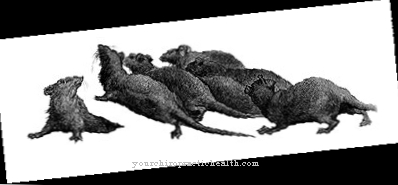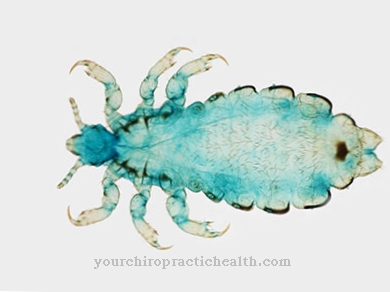The Barber-Say Syndrome is a rare hereditary disease with increased hairiness and noticeable facial physiognomy. So far, only ten cases have been documented since it was first described, so research into the syndrome is in its infancy. Neither the heredity nor the cause of the disease is known so far.
What is Barber Say Syndrome?

© adimas - stock.adobe.com
In 1982, N. Barber and his colleagues first described a disease called Barber-Say Syndrome. The disease has only been documented in ten patients since it was first described. It is estimated that the incidence for the syndrome is less than one case in 1,000,000 people. Barber-Say syndrome is believed to be a hereditary disease.
The exact type of inheritance is not yet known, but an autosomal dominant inheritance is suspected. The clinical picture is mainly characterized by hypertrichosis, which goes far beyond normal hair. As a rule, this is combined with atrophy of the skin, which makes the person affected appear emaciated and emaciated. In addition, misalignments of the eyelids and excessively wide mouth areas are often observed.
Because of the small number of documented cases, the Barber-Say syndrome is far from being conclusively researched. In particular, research into the causes is in its infancy, as the poorly documented cases do not provide a sound basis for a more in-depth etiology.
causes
Previous research suggests a hereditary basis for Barber-Say syndrome. In one case the symptom complex was transmitted from mother to son in a documented manner. In the case documented in this way, the mother also had a cleft palate and conductive hearing loss. In theory, the case mentioned could therefore have been a completely different syndrome.
Research to date has not shown whether the syndrome is based on an autosomal recessive, autosomal dominant or X-linked dominant inheritance. There is speculation in current medicine about a connection with the equally rare Ablepharon macrostomy syndrome. The two syndromes do not appear to be from the same group, but despite their differences, they appear to affect the same gene.
Presumably, the two diseases are different mutations of the same gene. However, nothing more is known about the gene locus in Ablepharon macrostomy syndrome.
Symptoms, ailments & signs
The Barber-Say syndrome mainly manifests itself in a congenital generalized hypertrichosis. The extreme hairiness of the patient is usually noticeable immediately after birth. The same applies to the eye-catching face of the person affected, which catches the eye with a broad bridge of the nose, an anteverted nose and particularly thin lips.
Despite the otherwise extreme hairiness, the patients lack eyebrows or are at least less pronounced. The eyelids are affected by misalignments or are completely absent. In addition, there is often hypertelorism or telekanthus. The same goes for malformed ears and overstretchable or excess skin. There may also be hypoplasia of the nipples. The complete absence of the mammary glands is an equally conceivable symptom.
Often times, teeth eruption is delayed in patients with Barber-Say syndrome. Presumably, in individual cases, additional symptoms may appear that have not yet been recorded due to the small number of documented cases.
Diagnosis & course
Diagnosing Barber-Say syndrome can be difficult. Since no specific gene has been held responsible for the syndrome so far, the molecular genetic examination of the patient is nowhere near. At best, the doctor makes the diagnosis by visual diagnosis, as he lacks solid diagnostic criteria.
The differential diagnosis and differentiation from the equally rare Ablepharon macrostomy syndrome is a difficult undertaking. Neither for the Barber-Say syndrome nor for the Ablepharon macrostomy syndrome has the etiology been conclusively clarified or narrowed down to a specific gene locus. The distinction between the two syndromes is mainly determined by the minor genital anomalies in Barber-Say syndrome. So far, medicine has assumed a rather favorable course of the disease for Barber-Say syndrome.
Complications
The clinical models of Barber-Say syndrome are increased hairiness and a conspicuous facial physiognomy. The hair of the patient goes far beyond the normal hair of healthy people, while the eyebrows are absent or less pronounced. The eyelids are misaligned or missing entirely.
An enlarged distance marks the eyes or the inner corners of the eyes. The mouth and nose area is exceptionally wide. The same abnormalities apply to malformed ears. In addition, there is tissue shrinkage in the skin, which makes the patient look emaciated and emaciated.
In some of those affected, tooth eruption occurs late. Since the Barber-Say syndrome has so far only been documented ten times worldwide, medicine is far removed from individual therapeutic approaches. Although the patient's life expectancy is not necessarily limited, the physiological complications are accompanied by a high level of psychological distress. Various cosmetic treatments and invasive interventions to remove excessive hair and conspicuous deformities are conceivable.
Drug therapy is also possible. However, in these cases there are often side effects that cause additional complications. The prognosis for a complete cure is negative, because the conspicuous symptoms and side effects of Barber-Say syndrome cannot be completely eliminated. To alleviate the psychosomatic complications, treatment by a psychotherapist is conceivable.
When should you go to the doctor?
Since Barber-Say syndrome is an extremely rare hereditary disease, a medical diagnosis is difficult. Typical symptoms such as the extreme hairiness and the conspicuous face of the patient are usually noticed immediately after the birth. Signs such as a wide bridge of the nose, missing eyebrows or particularly thin lips give cause for a more detailed examination. The clinical picture usually leads automatically to a routine physical diagnosis.
However, due to the small number of cases, a specific diagnosis of the syndrome is usually not possible. However, physical characteristics in the parents - in one documented case a cleft palate was found - as well as possible comorbidities can provide the decisive clues for the diagnosis of Barber-Say syndrome.
Parents with previous genetic diseases or cases of hereditary diseases in the extended family should address this in the context of pregnancy counseling and the associated medical examinations. This allows the child to be examined before birth and tested for possible genetic diseases such as Barber-Say syndrome.
Doctors & therapists in your area
Treatment & Therapy
The etiology of Barber-Say syndrome remains a mystery. For this reason, medicine is currently far from providing a causal treatment for the disease. As for the Ablepharon macrostomy syndrome, only symptomatic treatment options are possible. The treatment usually consists of mainly reconstructive-surgical interventions.
Reconstruction in Barber-Say syndrome is usually limited to the patient's eyelids and ears. If necessary, hypoplasias of the nipples can also be treated surgically. The noticeably wide nose can also be corrected by surgical intervention if necessary. The patients do not necessarily have to have the nose treated if they do not mind the width.
Basically, the ablepharon macrostomy syndrome has worse misalignments and anomalies than the Barber-Say syndrome. Various therapeutic approaches are available to combat the heavy hairiness of the Barber-Say syndrome. In addition to external treatments using cosmetic and aesthetic medicine methods, drug treatments are conceivable, but because of the side effects, these are only recommended for people with severe suffering.
Cosmetic procedures such as waxing or other methods such as laser treatment are usually gentler than long-term medication and are associated with significantly fewer side effects. Patients may face psychological challenges, especially during puberty. If this is the case, early contact with a psychotherapist ideally prevents those affected from withdrawing from society.
Outlook & forecast
The prognosis of the Barber-Say syndrome is considered unfavorable based on the medical and scientific possibilities available to date. Although the patient's life expectancy is not reduced, the disease is not cured. The genetic disease can be treated symptomatically. However, causal therapy is not possible for the patient.
Researchers and scientists are not allowed to manipulate human genetics in the search for therapeutic approaches. As a result, different options are attempted to treat the individual symptoms.
In addition to medical care, various alternative forms of treatment are available to the patient. The unusual and unwanted hair can be removed for a short time via waxing or targeted shaving. There is no permanent relief. Nevertheless, the methods can help to improve the patient's well-being in everyday life.
In addition to the cosmetic approaches, medical support is provided. The aim is to further improve health. The aim is to minimize the effects of the visual flaw. Some patients opt for cosmetic surgery in addition. Corrections to the face can be made to create a permanent change.
When making an overall prognosis, it must be taken into account that the surgical interventions are subject to the usual risks and side effects of an operation under general anesthesia.
prevention
The causes of Barber-Say syndrome are largely unknown. Since so little research is available for the symptom, the disease cannot yet be prevented. The same is true of the related disorder called Ablepharon Macrostomy Syndrome.
You can do that yourself
The Barber-Say syndrome is extremely rare, so far there are neither conventional medical nor alternative healing methods that have a causal effect.
The people affected by the Barber-Say syndrome usually suffer very badly from their external appearance, which significantly affects their quality of life. The social interaction is impaired, among other things, by the extremely strong hair growth all over the body. At the sight of these people, third parties are often frightened or consider the person concerned to be extremely neglected.
The excessive body hair can be dealt with with cosmetic means. The easiest way to get a close daily shave is with the help of a disposable razor and shaving foam or shaving gel from the drugstore. Annoying body hair can also be removed with depilatory creams based on potassium or ammonium salts of thioglycolic acid or thiolactic acid.
Long-lasting success can be achieved with methods in which the hair is pulled out along with the root. The most common methods include "waxing" and "sugaring". The body hair is removed with the help of wax or sugar. Such treatments are offered by cosmetic studios.
Since these methods are very painful, they are not suitable for all those affected and not for all body regions. Laser hair removal, on the other hand, is permanent and comparatively gentle. Interested parties can find out more from the dermatologist.
If there are other noticeable features in addition to the heavy hair, such as anomalies on the face, a plastic surgeon should be consulted.
Psychotherapy can be helpful if those affected suffer emotionally from their appearance.


.jpg)



.jpg)




















